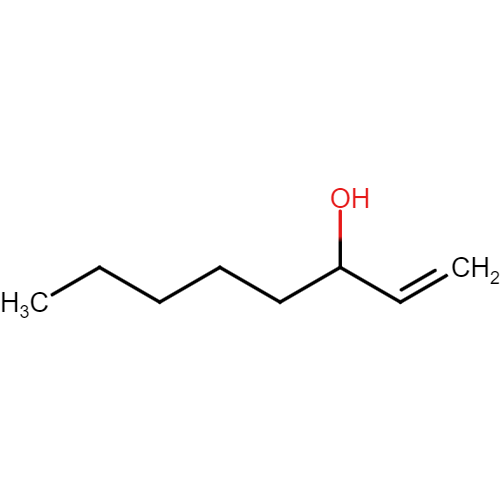1-Octan-3-ol
| Compound Structure: |

|
||||||||||||||||||||||||||||||||||||||||||||||||
|---|---|---|---|---|---|---|---|---|---|---|---|---|---|---|---|---|---|---|---|---|---|---|---|---|---|---|---|---|---|---|---|---|---|---|---|---|---|---|---|---|---|---|---|---|---|---|---|---|---|
| Synonyms: | 1-OCTEN-3-OL; Oct-1-en-3-ol;1-Vinylhexanol;Vinyl amyl carbinol;3-Hydroxy-1-octene;Amyl vinyl carbinol;Mushroom alcohol;Pentyl vinyl carbinol;Octen-3-ol;Matsuica alcohol;Vinyl hexanol;Pentylvinylcarbinol;octene-1-ol-3;Oct-1-ene-3-ol | ||||||||||||||||||||||||||||||||||||||||||||||||
| Compound ID: | NMPC-110 | ||||||||||||||||||||||||||||||||||||||||||||||||
| PubChem ID: | |||||||||||||||||||||||||||||||||||||||||||||||||
| Molecular Formula: | C8H16O | ||||||||||||||||||||||||||||||||||||||||||||||||
| Canonical SMILES: | CCCCCC(C=C)O | ||||||||||||||||||||||||||||||||||||||||||||||||
| InChIKey: | VSMOENVRRABVKN-UHFFFAOYSA-N | ||||||||||||||||||||||||||||||||||||||||||||||||
| About the compound: | Oct-1-en-3-ol is an alkenyl alcohol with a structure based on an unbranched C8 chain featuring the hydroxy group at C-2 and unsaturation at C-1 to C-2. It is a major volatile compound found in numerous mushrooms and fungi. This compound plays multiple roles as an insect attractant, a volatile oil component, a fungal metabolite, and an antimicrobial agent. Oct-1-en-3-ol is classified as an alkenyl alcohol and a fatty alcohol, deriving from the hydride of 1-octene. 1-Octen-3-ol, often referred to as octenol, is a natural compound that can be found in various organisms, including Nepeta nepetella and Origanum syriacum. It is a metabolite produced by Saccharomyces cerevisiae.1-Octen-3-ol is recognized for its role as a chemical that attracts biting insects like mosquitoes. It is present in human breath and sweat, and it is believed that insect repellents like DEET work by blocking the insects' octenol odorant receptors. This compound exists in two enantiomeric forms, namely (R)-(–)-1-octen-3-ol and (S)-(+)-1-octen-3-ol. Octenol is produced by various plants and fungi, including edible mushrooms and lemon balm, and is formed during the oxidative breakdown of linoleic acid. Interestingly, octenol can also be a wine fault, defined as a cork taint, and it occurs in wines made with grape bunches contaminated by rot. GHS Hazard Statements • H302 (96.75%): Harmful if swallowed [Warning Acute toxicity, oral] • H315 (99.89%): Causes skin irritation [Warning Skin corrosion/irritation] • H319 (99.89%): Causes serious eye irritation [Warning Serious eye damage/eye irritation] • H332 (97.37%): Harmful if inhaled [Warning Acute toxicity, inhalation] • H400 (94.01%): Very toxic to aquatic life [Warning Hazardous to the aquatic environment, acute hazard] |
||||||||||||||||||||||||||||||||||||||||||||||||
| Properties: |
Chemical and Physical Properties
Source: PubChem |
||||||||||||||||||||||||||||||||||||||||||||||||
| Source Species: |
Bryophyllum pinnatum Hyparrhenia rufa Acalypha segetalis Luffa cylindrica Pteris togoensis Tecoma stans |